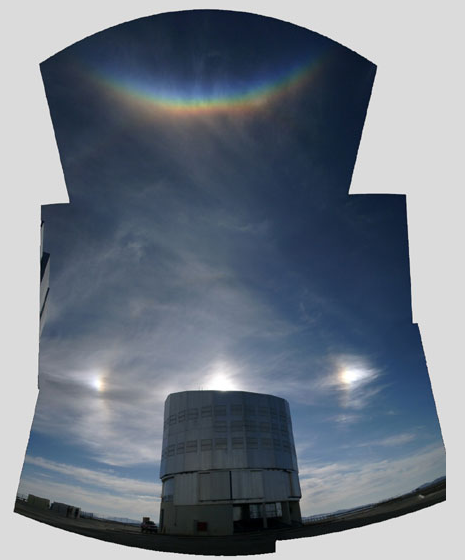Circumzenithal Arc, Paranal Observatory
Circumzenithal Arc at Paranal Observatory: A Stunning Atmospheric Optics Phenomenon
Located in the Atacama Desert of Chile, the Paranal Observatory is home to the European Southern Observatory's four optically coupled 8.2-meter telescopes. While the observatory is primarily known for its groundbreaking astronomical research, it is also a captivating site for atmospheric optics enthusiasts. One such phenomenon that graces the skies above Paranal is the mesmerizing Circumzenithal Arc (CZA). This article delves into the enchanting beauty of the CZA at Paranal Observatory and provides a deeper understanding of this fascinating atmospheric optical display.
The CZA is a rare and striking optical phenomenon that occurs when sunlight interacts with ice crystals suspended in the Earth's atmosphere. It manifests as an arc of vivid colors, resembling an upside-down rainbow, positioned directly above the zenith. While circumzenithal arcs can be observed in various locations around the world, the atmospheric conditions at Paranal make it an ideal spot for witnessing this celestial spectacle.
When the sun is relatively low in the sky and sundogs are present, it is a good indication that a CZA may be visible. Sundogs, also known as parhelia, are bright spots that appear on either side of the sun and are caused by the refraction of sunlight through ice crystals. The combination of sundogs and a low sun angle creates the perfect conditions for the formation of a CZA.
The CZA observed at Paranal on March 21st, 2002, was particularly remarkable. Captured by Sylvain Rondi, the panoramic view revealed not only the vivid CZA but also a faint supralateral arc descending from it. The supralateral arc, which curves downwards and is brightest on the left side, adds an extra touch of intrigue to this already captivating atmospheric display.
To fully appreciate the beauty of the CZA at Paranal, it is essential to understand the science behind its formation. The arc is created when sunlight enters hexagonal ice crystals in the atmosphere and undergoes a complex process of refraction and reflection. As the light interacts with the ice crystals, it bends and separates into its constituent colors, resulting in the stunning array of hues seen in the CZA.
The specific atmospheric conditions at Paranal contribute to the intensity and visibility of the CZA. The dry climate and high altitude of the Atacama Desert create an environment conducive to the formation of ice crystals in the upper atmosphere. These ice crystals act as prisms, refracting and dispersing sunlight to produce the vibrant colors of the CZA. Additionally, the lack of light pollution in the remote desert location further enhances the clarity and brilliance of this atmospheric phenomenon.
Witnessing a Circumzenithal Arc at Paranal Observatory is a rare treat for both astronomers and nature enthusiasts alike. The ethereal beauty of this optical display serves as a reminder of the intricate interactions between light and ice crystals in our atmosphere. Whether you are fortunate enough to observe it firsthand or marvel at photographs captured by talented individuals like Sylvain Rondi, the CZA at Paranal Observatory is an awe-inspiring testament to the wonders of our natural world.
In conclusion, the Circumzenithal Arc at Paranal Observatory is a breathtaking atmospheric optics phenomenon that mesmerizes all who have the opportunity to witness it. With its vibrant colors and unique positioning directly above the zenith, the CZA adds an extra touch of magic to the already awe-inspiring skies above Paranal. By understanding the science behind its formation and appreciating the ideal atmospheric conditions at Paranal, we can gain a deeper appreciation for this captivating celestial display. So, keep your eyes peeled for sundogs and a low sun angle, for they may just herald the appearance of a mesmerizing Circumzenithal Arc at Paranal Observatory.

Halos at Paranal, Chile site of the European Southern Observatory.
The sun is partly hidden by the housing of one of the four optically coupled 8.2 meter telescopes. A weak 22º halo circles the sun which is also flanked by sundogs. High above is a bright prismatic circumzenithal arc. Touching the CZA and curving downwards is a faint supralateral arc. It is brightest on the left.
Always look for a CZA when the sun is fairly low and there are sundogs.
Imaged on 21st March '02 when the sun was 22º high by Sylvain Rondi (site). He joined nine separate images to make this panoramic view. Another view.
Images ©2002 Sylvain Rondi, shown with permission.
Note: this article has been automatically converted from the old site and may not appear as intended. You can find the original article here.
Reference Atmospheric Optics
If you use any of the definitions, information, or data presented on Atmospheric Optics, please copy the link or reference below to properly credit us as the reference source. Thank you!
-
<a href="https://atoptics.co.uk/blog/circumzenithal-arc-paranal-observatory/">Circumzenithal Arc, Paranal Observatory</a>
-
"Circumzenithal Arc, Paranal Observatory". Atmospheric Optics. Accessed on November 26, 2024. https://atoptics.co.uk/blog/circumzenithal-arc-paranal-observatory/.
-
"Circumzenithal Arc, Paranal Observatory". Atmospheric Optics, https://atoptics.co.uk/blog/circumzenithal-arc-paranal-observatory/. Accessed 26 November, 2024
-
Circumzenithal Arc, Paranal Observatory. Atmospheric Optics. Retrieved from https://atoptics.co.uk/blog/circumzenithal-arc-paranal-observatory/.